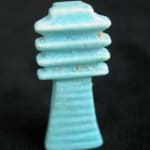New Kingdom Faience Amulet of a Djed Column, 1600 BCE - 600 BCE
Faience
1.125
FJ.5804
The first examples of amulets appeared in Ancient Egypt as early as 4000 B.C. Believed to possess magical powers that protected the wearer or bestowed upon the properties they symbolized,...
The first examples of amulets appeared in Ancient Egypt as early as 4000 B.C. Believed to possess magical powers that protected the wearer or bestowed upon the properties they symbolized, amulets were worn both by the living as well as the dead. Throughout their evolution, talismans were crafted from a variety of materials including precious metals such as gold and silver, semiprecious stone like jasper and carnelian, as well as other more affordable glazed compositions such as faience. The particular powers of an individual amulet were based upon its specific shape, although the material and even the color of the charm could affect its magical abilities. While many of the amulets created to be worn by the living could also be worn after death, there also existed a specific group of charms that were made specifically to be placed upon the mummified remains of the deceased. All together, amulets represent an important class of Ancient Egyptian art that furthers our understanding of their complex religious beliefs.
Faience, which dates back to predynastic times, at least 5,000 years, is a glasslike non-clay substance made of materials common to Egypt: ground quartz, crushed quartz pebbles, flint, a soluble salt-like baking soda, lime and ground copper, which provided the characteristic color. The dried objects went into kilns looking pale and colorless but emerged a sparkling "Egyptian blue." Called tjehnet by the Ancient Egyptians, meaning that which is brilliant or scintillating, faience was thought to be filled with the undying light of the sun, moon and stars and was symbolic of rebirth. Ancient Egyptians believed the small blue-green objects helped prepare them for eternity in the afterlife.
While the form of the djed column is fairly clear: a tall wide shaft crossed by four short horizontal lines at the top, its interpretation is surely enigmatic. Some scholars believe it originally represented a stylized palm tree, others suggest it was supposed to be a bundle of papyrus stalks. As a symbol, it first appears as early as the 3rd Dynasty; however, it was not until the end of the Old Kingdom that the djed appears as an amulet. By the New Kingdom, the djed column has come to be associated with Osiris, and the form was said to represent his backbone. In the Ancient Egyptian language, the word djed meant, “to endure” or “to be stable.” Thus, as an amulet, the djed column was supposed to infuse the wearer with the qualities of stability and endurance. As a funerary element, the Book of the Dead details instructions for placing the djed on the throat of the deceased. Yet despite these instructions, djed amulets have been found most often on the breast or stomach of mummies.
Faience, which dates back to predynastic times, at least 5,000 years, is a glasslike non-clay substance made of materials common to Egypt: ground quartz, crushed quartz pebbles, flint, a soluble salt-like baking soda, lime and ground copper, which provided the characteristic color. The dried objects went into kilns looking pale and colorless but emerged a sparkling "Egyptian blue." Called tjehnet by the Ancient Egyptians, meaning that which is brilliant or scintillating, faience was thought to be filled with the undying light of the sun, moon and stars and was symbolic of rebirth. Ancient Egyptians believed the small blue-green objects helped prepare them for eternity in the afterlife.
While the form of the djed column is fairly clear: a tall wide shaft crossed by four short horizontal lines at the top, its interpretation is surely enigmatic. Some scholars believe it originally represented a stylized palm tree, others suggest it was supposed to be a bundle of papyrus stalks. As a symbol, it first appears as early as the 3rd Dynasty; however, it was not until the end of the Old Kingdom that the djed appears as an amulet. By the New Kingdom, the djed column has come to be associated with Osiris, and the form was said to represent his backbone. In the Ancient Egyptian language, the word djed meant, “to endure” or “to be stable.” Thus, as an amulet, the djed column was supposed to infuse the wearer with the qualities of stability and endurance. As a funerary element, the Book of the Dead details instructions for placing the djed on the throat of the deceased. Yet despite these instructions, djed amulets have been found most often on the breast or stomach of mummies.



